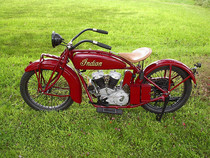Most people who know what the first motorcycles looked like have only a vague image in mind. Fewer are those who know the brands, models, and vintage of the bikes, and those few are becoming even rarer. As each new generation is further removed from true classic motorcycles, it takes their fathers, their grandfathers (or grandmothers), and friends to show them how it all began.
2011 marks the year that power sports brand Polaris takes the reins of the Indian motorcycle brand. The renewal of a name so instrumental in development of the motorcycle helps us remember where the two-wheeled metal beast came from. Though the Indian motorcycle was not the first, it was close. When the initial Indian model rolled out of the shop in 1901, it looked much like a bicycle with a motor on it. A far cry indeed from the cruisers and rockets we know today. With Harley-Davidson releasing its first model two years later, both companies found serious competition in each other.
From 1901 to 1953, Indian became known as a solid motorcycle for the casual rider, serious biker, policeman, soldier, and professional racer. Indian did it all, and with style. Most memorable are the art-deco curves of the skirted fenders and two-tone paint of the Indian Chiefs. Still popular were the Scout and Four. Despite all that went right with the company, there is a reason that the casual biker may not know what an Indian motorcycle looks like. The short story is that sales fell and Indian motorcycles stopped being produced in 1953.
For half a century, Indian motorcycle enthusiasts had only those aging bikes to remember the past. When several companies merged and announced they were reviving the Indian brand in 1999, tremors rocked the community of Indian fans. Would the new Indians live up to the legacy of the legend? Apparently not. Developers used aftermarket versions of Harley Davidson motors and frames with Indian-style sheet metal. To Indian purists, this was a betrayal and a serious lack of effort. Production ran for only four years before facing bankruptcy and bowing out.
2006 brought a new revival of the Indian brand, now called the Indian Motorcycle Company. Not much changed in the design from the 1999 version, but marketing the bikes as being exclusively rare helped keep it afloat.
With the new acquisition by Polaris, Indian motorcyclists can expect revamped designs, improved performance, and a distribution system that will make the bikes more accessible. Polaris has seen great success with its line of Victory cruisers, which have gained a reputation for being solid, well-built bikes. Some are hoping for the new Indians to be a true rebirth of the legend this time. Polaris may even be able to revive the widespread popularity of the Indian motorcycle. Only time will tell. Until then, nostalgic bikers are just as happy wrenching on the classic motorcycles they remember.


Leave a comment
You must be logged in to post a comment.